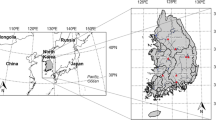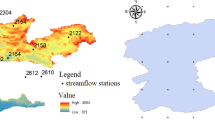Abstract
This study established a hydrological drought forecasting system based on the Bayesian method and evaluated its utilization for South Korea. The regression result between Historical Runoff (HR) and Ensemble Streamflow Prediction Runoff (ESP_R) was used as prior information in the Bayesian method. Additionally Global seasonal forecast System 5 Runoff (GS5_R) produced using a dynamic prediction method was used in a likelihood function. Bayesian Runoff (BAY_R), as posterior information, was generated and compared with the ESP_R and GS5_R results for predictive ability evaluation. The Standardized Runoff Index (SRI) was selected for the drought prediction, and the BAY_SRI, GS5_SRI and ESP_SRI were computed using BAY_R, GS5_R and ESP_R, respectively. The Correlation Coefficient (CC), Nash-Sutcliffe Efficiency (NSE) and Receiver Operating Characteristic (ROC) score of BAY_SRI were the highest, and the Root Mean Square Error (RMSE) of BAY_SRI was the lowest among the methods. The Bayesian method improved the behavioral and quantitative error of drought prediction and the predictive ability of the occurrence of drought. In particular, the simulation accuracy was significantly improved during the flood season. Additionally, BAY_SRI represented past drought scenarios better than did the other two methods. Overall, we found that the Bayesian method could be applied for hydrological drought predictions for based on 1- and 2-month lead times.





Similar content being viewed by others
References
Coelho CAS, Pezzulli S, Balmaseda M, Doblas-Reyes FJ, Stephenson DB (2004) Forecast calibration and combination: a simple Bayesian approach for ENSO. J Clim 17:1504–1516
Fang L, Qing-Cun Z, Chao-Fan L (2009) A Bayesian scheme for probabilistic multi-model ensemble prediction of summer rainfall over the Yangtze River valley. Atmos Oceanic Sci Lett 2:314–319
Gelman A (2003) A Bayesian formulation of exploratory data analysis and goodness-of-fit testing. Int Stat Rev 71:369–382
Gobena AK, Gan TY (2010) Incorporation of seasonal climate forecasts in the ensemble streamflow prediction system. J Hydrol 385:336–352
Hosking JRM, Wallis JR (1993) Some statistics useful in regional frequency analysis. Water Resour Res 29:271–281
Jung IW, Chang HJ (2012) Climate change impacts on spatial patterns in drought risk in the Willamette River basin, Oregon, USA. Theor Appl Climatol 108:355–371
Kim JH, Bae DH (2006) Probabilistic medium- and long-term reservoir inflow forecasts (H) use of GDAPS for ensemble reservoir inflow forecasts. Korea Water Resour Assoc 39:275–288
Koster RD, Mahanama SPP, Yamada TJ, Balsamo G, Berg AA, Boisserie M, Dirmeyer PA, Doblas-Teyes FJ, Drewitt G, Gordon CT, Guo Z, Jeong JH, Lawrence DM, Lee WS, Luo L, Mayshev S, Merryfield WJ, Seneviratne SI, Stanelle T, van den Hurk BJJM, Vitart F, Wood EF (2010) Contribution of land surface initialization to subseasonal forecast skill: first results from a multi-model experiment. Geophys Res Lett 37:L02402
Lavers D, Luo L, Wood EF (2009) A multiple model assessment of seasonal climate forecast skill for applications. Geophys Res Lett 36:L23711
Lee JH, Kim CJ (2012) A multi-model assessment of the climate change effect on the drought severity–duration–frequency relationship. Hydrol Process. doi:10.1002/hyp.9390
Li H, Luo L, Wood EF, Schaake J (2009) The role of initial conditions and forcing uncertainties in seasonal hydrologic forecasting. J Geophys Res 114:DO04114
Liang X, Lettenmaier DP, Wood EF, Burges SJ (1994) A simple hydrologically based model of land surface water and energy fluxes for general circulation models. J Geophys Res 99:14415–14428
Luo L, Wood EF, Pan M (2007) Bayesian merging of multiple climate model forecasts for seasonal hydrological predictions. J Geophys Res 112:D1027
Mo KC, Shukla S, Lettenmaier DP, Chen L (2012) Do climate forecast system (CFSv2) forecasts improve seasonal soil moisture prediction? Geophys Res Lett 39:L23703
Shukla S, Lettenmaier DP (2011) Seasonal hydrologic prediction in the United States: understanding the role of initial hydrologic conditions and seasonal climate forecast skill. Hydrol Earth Syst Sci 15:3529–3538
Shukla S, Wood AW (2008) Use of a standardized runoff index for characterizing hydrologic drought. J Geophys Res 35:L2045
Singh V, Fiorentino M (1996) Geographical information systems in hydrology. Kluwer Academic Publishers, Boston
Sohn KH, Bae DH, Ahn JH (2014) Projection and analysis of drought according to future climate and hydrological information in Korea. J Korea Water Resour Assoc 47:71–82
Son KH, Bae DH, Chung JS (2011) Drought analysis and assessment by using land surface model on South Korea. J Korea Water Resour Assoc 44:667–681
Thober S, Kumar R, Sheffield J, Mai J, Schäfer D, Samaniego L (2015) Seasonal soil moisture drought prediction over Europe using the north American multi-model ensemble (NMME). J Hydrometeorol 16:2329–2344
Trambauer P, Werner M, Winsemius HC, Maskey S, Dutra E, Uhlenbrook S (2014) Hydrological drought forecasting and skill assessment for the Limpopo river basin, southern Africa. Hydrol Earth Syst Sci 11:9961–10000
Wang D, Hejazi M, Cai X, Vaocchi AJ (2011) Climate change impact on meteorological, agricultural, and hydrological drought in central Illinois. Water Resour Res 47:W09527
Wood AW, Lettenmaier DP (2008) An ensemble approach for attribution of hydrologic prediction uncertainty. Geophys Res Lett 35:L14401
Wood AW, Schaake JC (2008) Correcting errors in streamflow forecast ensemble mean and spread. J Hydrometeorol 9:132–148
Yoon JH, Mo K, Wood EF (2012) Dynamic-model-based seasonal prediction of meteorological drought over the contiguous United States. J Hydrometeorol 13:463–482
Yuan X, Wood EF, Chaney NW, Sheffield J, Kam J, Liang M, Guan K (2013) Probabilistic seasonal forecasting of African drought by dynamical models. J Hydrometeorol 14:1706–1720
Acknowledgements
This work was funded by the Korea Meteorological Administration Research and Development Program under Grant KMIPA 2015-2070.
Author information
Authors and Affiliations
Corresponding author
Rights and permissions
About this article
Cite this article
Bae, DH., Son, KH. & So, JM. Utilization of the Bayesian Method to Improve Hydrological Drought Prediction Accuracy. Water Resour Manage 31, 3527–3541 (2017). https://doi.org/10.1007/s11269-017-1682-x
Received:
Accepted:
Published:
Issue Date:
DOI: https://doi.org/10.1007/s11269-017-1682-x




